Families Sickened by Fracking
Air Date: Week of March 19, 2021
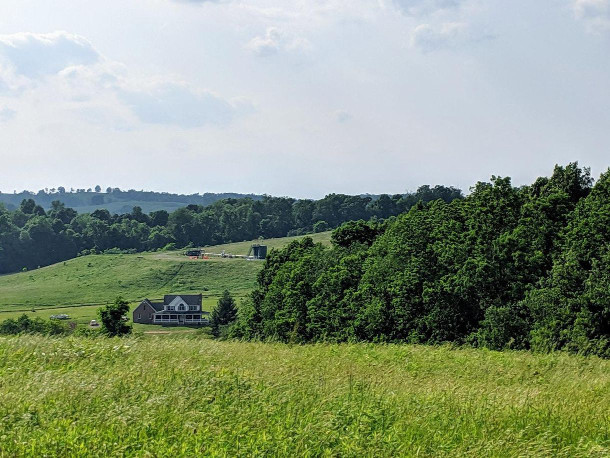
A bird's-eye view of Bryan and Ryan Latkanich's home and the fracking well pad up the hill behind it in the summer of 2019. (Credit: Kristina Marusic for Environmental Health News)
The fracking boom transformed large swaths of rural America, turning towns from idyllic to industrial, and threatening the physical and mental health of many inhabitants. In a four-part series for Environmental Health News, Kristina Marusic tested five different families for 40 different chemicals associated with fracking and found that every person studied was carrying a massive chemical body burden. She joins Host Bobby Bascomb to talk about the families whose lives have been upended by their local fracking operations.
Transcript
BASCOMB: When fracking facilities move in next door, they can completely upend rural life for many people. And there are serious health concerns associated with the chemicals used for fracking. Typically, a cocktail of generally toxic chemicals and water is injected into bedrock to create cracks through which oil and natural gas can be extracted. The chemicals each company uses are proprietary information not available to the communities where fracking occurs. But the water, air, and people can be sampled to get a sense of what chemicals are present. And in a 5-part series for Environmental Health News investigative reporter Kristina Marusic did just that. In addition to water and air testing, she took urine samples from 5 different families over the course of 9 weeks during the summer of 2019. Each of the families had at least 1 child in the home. Kristina sent the samples to the University of Missouri to analyze them and compared the chemical body burden for each of the families living near fracking with the national average. The results show very high levels for many of the 40 chemicals and chemical breakdown products they tested for including benzene, styrene, and toluene. In some of the children tested they found chemical levels more than 90 times higher than the national average, higher even than an adult smoker. Kristina started by telling me about a family that moved to the area in search of a peaceful place to raise their children.
MARUSIC: So the Bower-Bjornson family, the mom, Lois and the dad, Dave originally lived in Pittsburgh's north side, which is like a trendy neighborhood close to downtown here. And when they knew they were going to start a family, they wanted more space. So they started looking for houses a little further away from the city. And initially, they were looking in suburbs closer to Pittsburgh, but then they were out in Washington County and saw this beautiful home listed that had a barn on the property, and was kind of in the middle of the country. And they just fell in love with the idea of raising their kids somewhere so idyllic. They live in a neighborhood called Scenery Hill, which is an apt name for it, because it's these big, green, lush rolling hills with little patches of woods here and there, and family farms all over the place, and like a cute little Main Street with a cafe and a pie shop. So they moved there as a young family, before fracking had moved into the area. And within a few years of their being there, the fracking boom started, so fracking wells started to move in. And when that first started happening, they actually weren't overly concerned, they kind of thought, oh, this might be good for the economics of the region. Maybe it'll help the mom and pop shops. They actually sold, not their mineral rights, but they like leased part of their property to run a an oil and gas transmission line through for something like $12,000 in the early days of the boom to a fracking company. But pretty quickly, this kind of idyllic country lifestyle pretty drastically started to change. So all of a sudden, this small two lane road that's right in front of their house was inundated with heavy truck traffic. So there were dozens of huge trucks going by every day, the wells were close enough to their house that they could hear the drilling, they could smell the drilling, they could see flaring like these huge flames licking into the air at night. One of their four children, Gunnar, started getting nosebleeds pretty regularly. And they worried that it might be related to emissions from fracking.
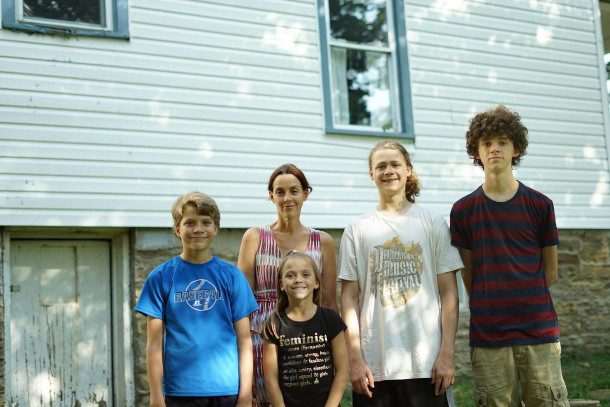
The Bower-Bjornson family (from left, Gunnar, Lois, Odessa, Nels and Kylan) at their home in Scenery Hill, PA. (Credit: Connor Mulvaney for Environmental Health News)
And Gunnar actually told me that once he got a pretty bad nosebleed in school, and he remembered asking his teacher not to tell his mom about it, because he knew that it made her really worried and stressed her out. So he didn't want her to know that he'd had a nosebleed at school. And then the gas line that takes gas from the main line into their house for you know, heating their home and for gas to their stove, ruptured. It ran under that little road, and so they felt almost certain that it ruptured, because of all this new heavy truck traffic. They had to pay to replace it, which was frustrating for them. So they just kind of became increasingly frustrated. They felt like this beautiful country property they had bought all of a sudden was in the middle of this heavy industry, which wasn't what they had signed up for. And so, you know, they were interested in getting tested because they were concerned about the potential for these exposures. They were concerned that, you know, it might have been causing their headaches and their rashes and their nosebleeds for several years. And then when they got the results of our study, they were pretty shocked to see in particular that the kids had some of these really high levels of exposures. And some of the highest levels of exposure we saw were in Gunnar, the child who had had the nosebleeds for years on and off.
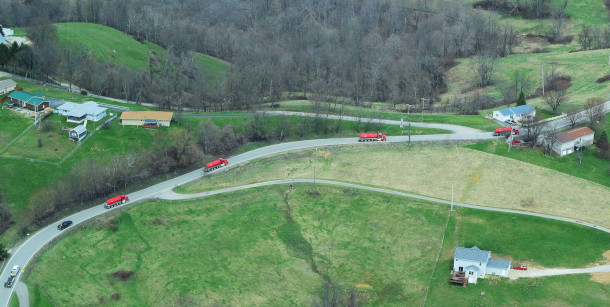
A line of fracking wastewater trucks in Moundsville, West Virginia (Credit: Ted Auch, FracTracker Alliance, 2019)
BASCOMB: And you write that they actually live now within five miles of about 25 active wells, many of which have several well pads each. I mean, that's a lot of industry in this formerly, you know, bucolic neighborhood.
MARUSIC: Yeah, it really has kind of changed the landscape there. When we got the test results back and I shared them with the family. She said, unless we move, there's no escaping this for us. We're completely surrounded by wells on all sides. And even when the kids go to school or to a friend's house, you know, unless they're leaving the state, they're still going to be near a fracking well, so they just feel kind of inundated and overwhelmed by the industry.
BASCOMB: So in addition to the physical health problems that you describe, you also say that there's some mental health consequences of living near fracking. Can you tell us more about that?
MARUSIC: Yeah. So there have been a number of studies that have found that people who live closer to a higher volume of fracking wells are more likely to experience things like depression, and anxiety, and trouble sleeping. And then there have been some other studies, some sociological studies that investigated why this is happening through things like surveys. And some of the reasons they found are, like I described with the Bower-Bjornson, a sense of loss that the place that they lived has been transformed from somewhere rural and quiet and peaceful into like a heavy industrial zone. Other reasons are worry and stress over the environmental impacts and the potential health impacts of fracking. And then a sense of distress in communities and alienation that happens. So some of these families we spoke to, one woman told me that she and her grandchildren had been screamed at at a community meeting by people who were making some money as a result of having leased their mineral rights. And were angry that someone whose kid was sick, who thought they were experiencing health problems as a result of fracking might get in the way of that. And so she reported that they felt really alienated and ostracized, and one of the teenagers who was involved in the study, she was 15. In the summer of 2019, we collected these samples, she asked to use a pseudonym, so we call her Lexy in the series, and she had been sick on and off for years after a fracking well went in about a half mile away from her elementary school.
And, you know, they went back and forth with a toxicologist and with the State Department of Health and they weren't getting answers, weren't getting answers. And eventually, their toxicologist found that Lexy had been exposed to benzene. But her toxicologist at this time suggested that the course of treatment was to remove her from the source of exposure, which was her school as hard as they knew. So it's a single grandmother raising Lexy and her brother and she was just like, what am I supposed to do? You know, do I pull them out of school, do we move? And her toxicologist at the time said she likely had a particular sensitivity to benzene. And I should back up and say at the beginning of all this, when she started getting sick, and they went to just their primary care doctor, they had tried everything. They had, you know, switch their detergent, they had ripped up all the carpeting in their house, they tried food elimination diets, they had tried thing after thing after thing, and nothing was helping. And then it eventually came out that she had been exposed to benzene and that she had a particular sensitivity to benzene exposure. And she had a really hard time at school, she wore an air monitor that would make noise if the levels of VOCs got above a certain limit. But then that became embarrassing for her. She was in middle school at the time, and it would like make this loud noise. And then all of her classmates would know. And then her teachers would be frustrated because that was disruptive. And they would ask her to leave. She got like violently ill at school, and vomited in front of everyone. So she felt like she just became that sick girl.
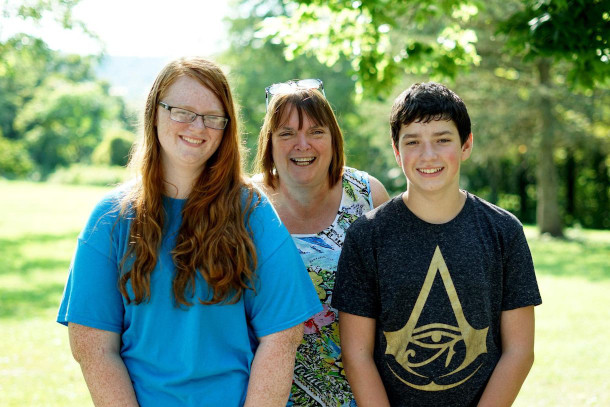
Lexy, Jane Worthington and Damien. (Credit: Connor Mulvaney for Environmental Health News)
And then she had fellow classmates saying things to her like, are you just making this all up? Are you lying? My mom says you're lying about this to get attention or the rest of us would all be sick if this was really happening. So, how come you're the only one sick? And she told me that she had experiences where she went to a friend's house on a couple occasions and the friend's parents wouldn't stop grilling her about, you know, tell the truth. Are you making this up? Are you really sick? And they eventually moved because they felt so ostracized in this community. And they had moved when we did our testing and unfortunately, we still found evidence that Lexy was being exposed to benzene. So they were left feeling really frustrated. And Lexy in particular reported a lot of mental health impacts as a result of this, you know, she developed anxiety, she got depressed because she felt like there was nothing that they could do about this. And yeah, she's someone who has just really struggled with the way that living around this industry has impacted her life as a young person.
BASCOMB: Well, you write about another family in your series. This was a father and son, where the father was happy to allow fracking on his property some time back, but then kind of regretted that decision. Can you tell us more about that story?
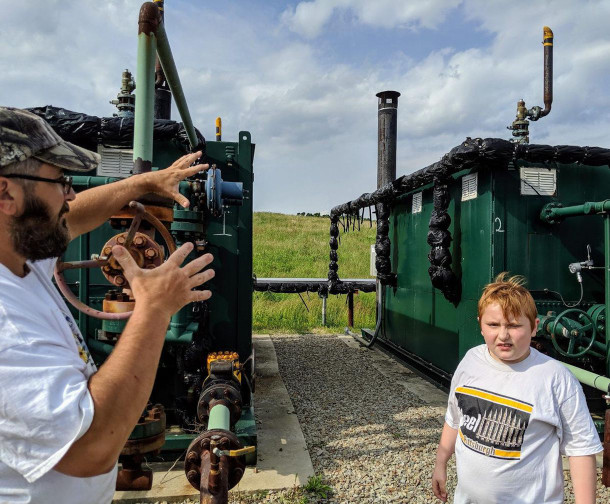
Bryan and Ryan Latkanich in front of the fracking infrastructure that was formerly active on their property in the summer of 2019. (Credit: Kristina Marusic for Environmental Health News)
MARUSIC: Yeah, so that is Brian Latkanich, and he's a single dad. His son, Ryan lives at home with him. And they invited a fracking company to drill a well on their property kind of early on in the boom, around 2011. In Pennsylvania, and in a lot of other states, there's something called a setback rule, which determines how far away a fracking well has to be from like a home or a school. In Pennsylvania, that distance currently is 500 feet. But if a property owner waives their rights, then it can be closer and that was something that Brian Latkanich opted to do. So the well pad was drilled about 400 feet from his house, and he was really gung ho about this. At the beginning, he described himself as a cheerleader for the industry because he was so excited about the royalties he was promised and he thought that they were going to become millionaires and move the house and sell somewhere else and get something bigger. But then, pretty quickly after the well went in, Brian and Ryan both started experiencing a whole slew of health problems, things like nosebleeds, rashes, trouble breathing, eye irritation. They've both had some pretty severe stomach problems. And at one point, Ryan, he was nine years old at the time that we did our testing. And he had a level of hippuric acid, which is a biomarker for toluene, in his urine that was more than 91 times as high as the US median, and almost five times as high as the US 95th percentile. At the time that wells went in, he was really little. And a couple years after it had been drilled, he came out of the bathtub with sores all over his body. And that was the beginning of Brian's experience, trying to work with state agencies here in Pennsylvania to get help for this. So he called the State Department of Environmental Protection, he called the State Department of Health, they had their water tested, and he has a private well. And after numerous tests, the State Department of Environmental Protection, told him essentially your water is to contaminate to drink, don't drink it, but that they didn't believe the fracking company was to blame or that they couldn't prove definitively that it had been to blame. So that meant that the fracking company wasn't required to provide him with water. So he had to start buying bottled water for him and Ryan, but they still had to bathe in this water and obviously, that was a concern. So they contacted the State Department of Health about that. And the State Department of Health advised them that if they were concerned that they should shower elsewhere. They recommended going to the nearest YMCA to shower and the nearest YMCA is about a 30 minute drive for him. So, right it just didn't seem feasible, what are they going to go every day to shower outside of their home indefinitely? The royalties were also much, much smaller than he had says he had been led to believe. So he was expecting to get huge amounts of money from this. And instead, it turned out to be not a whole lot. So, he is disabled and on a fixed income. So he feels that he can't afford to move, he feels stuck there.
BASCOMB: So just to be clear, he was saying his water was fine, there was no problem. And then fracking comes in 400 feet from his house, suddenly the water is too toxic for them to consume or bathe then, but the DEP finds that the fracking company is not responsible.
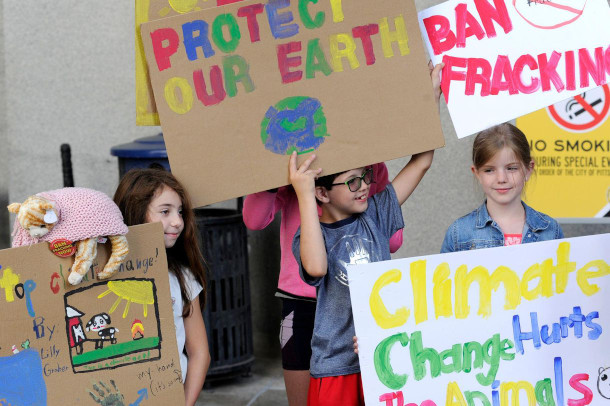
Children from two families involved in EHN's study participate in a 2019 youth climate change protest in downtown Pittsburgh. (Credit: Connor Mulvaney, Environmental Health News)
MARUSIC: Yeah, and that happens a lot. There was a big report by a newspaper, Public Herald, a couple of years ago that looked at all of the water complaints related to fracking in the state, and found that more than 90% of the time, when the Pennsylvania Department of Environmental Protection had investigated, they had ruled exactly like they did in Brian's case, which is that a fracking company couldn't be held liable for water contamination. So there are a lot of environmental advocates who are saying something looks wrong here. How is it possible that all of these thousands and thousands of people have had their water contaminated? And you know, there are fracking wells going in nearby? And so people obviously think that maybe that has something to do with it. And then you know, the DEP is finding that it doesn't. And there are a lot of reasons for that. But a big one is that this industry is relatively unregulated at the federal level. And so that leaves regulation up to the states, and the states that have to oversee and regulate these industries often are underfunded in the departments that do this kind of work. So you know, it might not necessarily be any kind of nefarious collusion with oil and gas, but it might just be a lack of resources. And that's something that I heard from a lot of these families that, you know, they just felt that they weren't getting answers, and they weren't getting help.
BASCOMB: Well, you know, of course, knowledge is power. So these families, they have this information now about the chemical body burden that they're carrying around. But what can they do with that? What are they planning to do now that they know how toxic their community and their homes are?
MARUSIC: I hope that having these test results will empower them to be able to better advocate for their health, for the health of their kids, and for the safety of their communities. And I have seen that start to happen since the series was published. So Lois Bower-Bjornson , who is the mom in the Bower-Bjornson family we talked about, has been CC-ing me on emails to every Pennsylvania state lawmaker she can find contact information for and saying, my family is one of the families that was studied here. She was very upset to learn about these exposures. But she also said, you know, I feel like for years people have been saying, maybe she's crazy. Maybe she's making it up. Maybe she's just being dramatic. And now I have proof. This is happening to me and my family. We have these high level of exposures. You know, we did these scientific tests that show that we have these level of exposures. So who is going to help us? What are you going to do to protect us? And so, I've been glad to see that she feels empowered by having this information to advocate for her family. And you know, I think the first next step is for someone to do similar research on a much larger scale. But I also think that what I found in this investigation should serve as a wake up call about the need to better understand whether fracking chemicals are getting into the air or water or bodies of people who are living near wells. And I also think, you know, it's not partisan to say that we're opposed to children being poisoned. And so I think this testing that we did clearly shows the need for more careful oversight of this industry, and for better systems in place to help serve these families who just feel like they're being put in harm's way and no one is there to help them or look out for them.
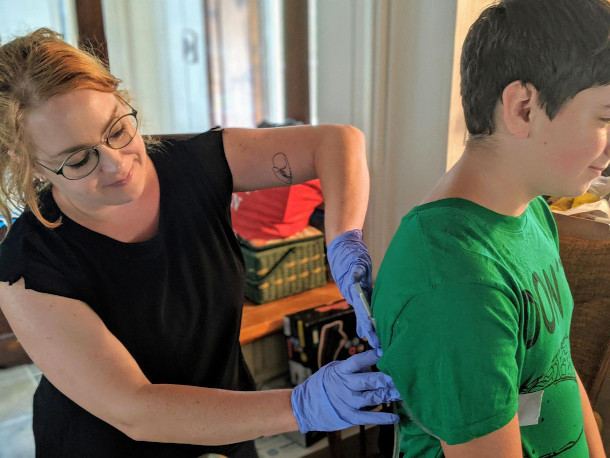
EHN reporter Kristina Marusic (left) sets up an air monitor for Damien Schaffer (right). (Credit: Mason Secreti)
BASCOMB: Kristina Marusic is an investigative reporter with Environmental Health News. Kristina, thank you so much for sharing this time with me and this really compelling investigation you've done.
MARUSIC: Yeah, thank you so much for talking with me. I really appreciate it.
Links
Click here for the ‘Fractured’ landing page
Environmental Health News | “Fractured: The Stress of Being Surrounded”
Environmental Health News | “Fractured: Distrustful of Frackers, Abandoned by Regulators”
Environmental Health News | “Fractured: Buffered From Fracking but Still Battling Pollution”
Learn more about how Environmental Health News collected and analyzed their data
Living on Earth wants to hear from you!
Living on Earth
62 Calef Highway, Suite 212
Lee, NH 03861
Telephone: 617-287-4121
E-mail: comments@loe.org
Newsletter [Click here]
Donate to Living on Earth!
Living on Earth is an independent media program and relies entirely on contributions from listeners and institutions supporting public service. Please donate now to preserve an independent environmental voice.
NewsletterLiving on Earth offers a weekly delivery of the show's rundown to your mailbox. Sign up for our newsletter today!
 Sailors For The Sea: Be the change you want to sea.
Sailors For The Sea: Be the change you want to sea.
 The Grantham Foundation for the Protection of the Environment: Committed to protecting and improving the health of the global environment.
The Grantham Foundation for the Protection of the Environment: Committed to protecting and improving the health of the global environment.
 Contribute to Living on Earth and receive, as our gift to you, an archival print of one of Mark Seth Lender's extraordinary wildlife photographs. Follow the link to see Mark's current collection of photographs.
Contribute to Living on Earth and receive, as our gift to you, an archival print of one of Mark Seth Lender's extraordinary wildlife photographs. Follow the link to see Mark's current collection of photographs.
 Buy a signed copy of Mark Seth Lender's book Smeagull the Seagull & support Living on Earth
Buy a signed copy of Mark Seth Lender's book Smeagull the Seagull & support Living on Earth

